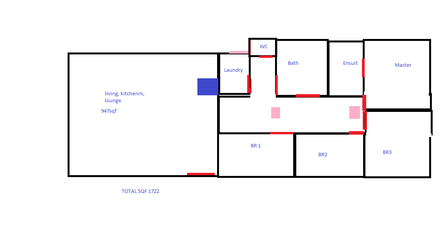Hi experts,
I'm about to decide on a stove and would like some last minute assurance on a stove size.
I'm choosing between 2cbf stove and a 2.7cbf stove.
I have attached a rough plan of the house.
I live in Australia in a climate considered temperate. We usually burn from mid Autumn to early Spring.
Mid winter minimum temps can get to 23f or a bit less and daytime highs usually hover between 40f to 55f.
I've been told the climate is similar to coastal Pacific North West.
The roof is very well insulated but there's no insulation anywhere else. Cellular blinds throughout. I will probably insulate the walls and floors soon.
the pink squares are outlets for a ducting system that uses an inline fan to draw air from the ceiling about the heater to down the hall. These are perfectly legal in Australia and widely used. They work very well to transfer residual heat about the stove to other areas.
The blue square is the proposed woodstove area. This works for a number of reasons including existing furniture and the roof peak, trees, etc.
Total house area is around 1700sqf. Single level. All the bathroom and laundry doors are always closed.
Would appreciate any advice about firebox size.
Thanks,
Tom.

I'm about to decide on a stove and would like some last minute assurance on a stove size.
I'm choosing between 2cbf stove and a 2.7cbf stove.
I have attached a rough plan of the house.
I live in Australia in a climate considered temperate. We usually burn from mid Autumn to early Spring.
Mid winter minimum temps can get to 23f or a bit less and daytime highs usually hover between 40f to 55f.
I've been told the climate is similar to coastal Pacific North West.
The roof is very well insulated but there's no insulation anywhere else. Cellular blinds throughout. I will probably insulate the walls and floors soon.
the pink squares are outlets for a ducting system that uses an inline fan to draw air from the ceiling about the heater to down the hall. These are perfectly legal in Australia and widely used. They work very well to transfer residual heat about the stove to other areas.
The blue square is the proposed woodstove area. This works for a number of reasons including existing furniture and the roof peak, trees, etc.
Total house area is around 1700sqf. Single level. All the bathroom and laundry doors are always closed.
Would appreciate any advice about firebox size.
Thanks,
Tom.


